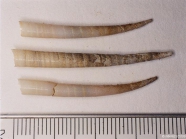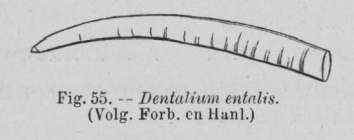
| Introduction | | Search taxa | | Taxon tree | | Taxon match | | Checklist | | Literature | | Stats | | Photogallery | | OBIS Vocab | | Log in |
WoRMS taxon detailsAntalis entalis (Linnaeus, 1758)
150534 (urn:lsid:marinespecies.org:taxname:150534)
accepted
Species
Antalis entale (Linnaeus, 1758) · unaccepted > misspelling - incorrect subsequent spelling (species name entalis is...)
species name entalis is invariable Antalis entale stimpsoni (J. B. Henderson, 1920) · unaccepted
Dentalium (Antalis) entale [sic] · unaccepted (misspelling)
Dentalium (Antalis) entale stimpsoni J. B. Henderson, 1920 · unaccepted > junior subjective synonym
Dentalium (Antalis) entalis Linnaeus, 1758 · unaccepted
Dentalium entalis Linnaeus, 1758 · unaccepted > superseded combination (currently placed in genus...)
currently placed in genus Antalis Dentalium entalis var. anulata Jeffreys, 1865 · unaccepted (synonym)
Dentalium entalis var. infundibulum Jeffreys, 1869 · unaccepted (synonym)
Dentalium stimpsoni J. B. Henderson, 1920 · unaccepted > junior subjective synonym
Dentalium striolatum W. Stimpson, 1851 · unaccepted > junior homonym (invalid: junior homonym of...)
invalid: junior homonym of Dentalium striolatum Risso, 1826; Dentalium (Antalis) entale stimpsoni Henderson, 1920 is a replacement name
marine,
(of Dentalium entalis Linnaeus, 1758) Linnaeus, C. (1758). Systema Naturae per regna tria naturae, secundum classes, ordines, genera, species, cum characteribus, differentiis, synonymis, locis. [The system of nature through the three kingdoms of nature, according to classes, orders, genera, species, with characters, differences, synonyms, places.]. <em>Impensis Direct. Laurentii Salvii. Holmiae [Stockholm].</em> 1(10) [iii], 824 p., available online at https://biodiversitylibrary.org/page/726886
page(s): 785 [details] Available for editors
Note Atlantic Ocean, without a precise locality
Type locality Atlantic Ocean, without a precise locality [details]
Distribution 60°N to 42°N; 70°W to 45°W, Nova Scotia to Cape Cod, Mass.; Gulf of St. Lawrence (unspecified region); southern Gaspe...
Distribution 60°N to 42°N; 70°W to 45°W, Nova Scotia to Cape Cod, Mass.; Gulf of St. Lawrence (unspecified region); southern Gaspe waters (Baie des Chaleurs, Gaspe Bay to American, Orphan and Bradelle banks; eastern boundary: eastern Bradelle Valley), 8 to 2195 m (live 8 to 48 m) [details] Distribution All coasts, but uncommon in south, not present around Channel Islands
Distribution All coasts, but uncommon in south, not present around Channel Islands [details]
MolluscaBase eds. (2025). MolluscaBase. Antalis entalis (Linnaeus, 1758). Accessed through: World Register of Marine Species at: https://www.marinespecies.org/aphia.php?p=taxdetails&id=150534 on 2025-07-17
Date action by
Nomenclatureoriginal description
(of Dentalium entalis Linnaeus, 1758) Linnaeus, C. (1758). Systema Naturae per regna tria naturae, secundum classes, ordines, genera, species, cum characteribus, differentiis, synonymis, locis. [The system of nature through the three kingdoms of nature, according to classes, orders, genera, species, with characters, differences, synonyms, places.]. <em>Impensis Direct. Laurentii Salvii. Holmiae [Stockholm].</em> 1(10) [iii], 824 p., available online at https://biodiversitylibrary.org/page/726886 page(s): 785 [details] Available for editors original description (of Dentalium striolatum W. Stimpson, 1851) Stimpson, W. (1851). On several new species of shells from the northern coast of New England. <em>Proceedings of the Boston Society of Natural History.</em> 4: 113-114., available online at https://www.biodiversitylibrary.org/page/8870823 page(s): 114 [details] original description (of Dentalium entalis var. infundibulum Jeffreys, 1869) Jeffreys, J. G. (1862-1869). <i>British conchology</i>. Vol. 1: pp. cxiv + 341 [1862]. Vol. 2: pp. 479 [1864]. Vol. 3: pp. 394 [1865]. Vol. 4: pp. 487 [1867]. Vol. 5: pp. 259 [1869]. London, van Voorst. , available online at http://www.biodiversitylibrary.org/item/55187 page(s): 197 [details] original description (of Dentalium entalis var. anulata Jeffreys, 1865) Jeffreys, J. G. (1862-1869). <i>British conchology</i>. Vol. 1: pp. cxiv + 341 [1862]. Vol. 2: pp. 479 [1864]. Vol. 3: pp. 394 [1865]. Vol. 4: pp. 487 [1867]. Vol. 5: pp. 259 [1869]. London, van Voorst. , available online at http://www.biodiversitylibrary.org/item/55187 [details] original description (of Dentalium (Antalis) entale stimpsoni J. B. Henderson, 1920) Henderson, J. B. (1920). A monograph of the east American scaphopod mollusks. <em>United States National Museum Bulletin.</em> 111(20): 1-177., available online at http://www.biodiversitylibrary.org/item/33255 page(s): 35-38, pl. 4, figs 2-4; note: replacement name for Dentalium striolatum Stimpson, 1851, non Risso, 1826 [details] basis of record Hayward, P.J. & J.S. Ryland (Eds.). (1990). The marine fauna of the British Isles and North-West Europe: 1. Introduction and protozoans to arthropods. <em>Clarendon Press: Oxford, UK.</em> 627 pp. (look up in IMIS) [details] Available for editors Taxonomystatus source
Steiner, G.; Kabat, A. R. (2004). Catalog of species-group names of Recent and fossil Scaphopoda (Mollusca). <em>Zoosystema.</em> 26 (4): 549-726., available online at https://sciencepress.mnhn.fr/en/periodiques/zoosystema/26/4/catalogue-des-noms-du-groupe-espece-de-scaphopodes-mollusca-recents-et-fossiles [details] Otheradditional source
Ivanov, D. L. & Zarubina, E. M. (2004). Distribution of scaphopod mollusks (Mollusca, Scaphopoda) in the North Atlantic and Arctic oceans, based on materials of Russian and Soviet expeditions. <em>Ruthenica.</em> 14(1): 89-104.
page(s): 90, figs. 1A, 4 [details] additional source Morton J.E. 1959. The habits and feeding organs of <i>Dentalium entalis</i>. <i>Journal of the Marine Biological Association of the United Kingdom</i> 38(2): 225-238., available online at http://sabella.mba.ac.uk/1985/01/The_habits_and_feeding_organs_of_Dentalium_entalis.pdf [details]  Present Present  Present in aphia/obis/gbif/idigbio Present in aphia/obis/gbif/idigbio  Inaccurate Inaccurate  Introduced: alien Introduced: alien  Containing type locality Containing type locality
From editor or global species database
Type locality Atlantic Ocean, without a precise locality [details]Unreviewed
Diet feed on mainly foraminiferans [details]Dimensions general, tusk shells range from less than 5 mm to 90 mm [details] Distribution 60°N to 42°N; 70°W to 45°W, Nova Scotia to Cape Cod, Mass.; Gulf of St. Lawrence (unspecified region); southern Gaspe waters (Baie des Chaleurs, Gaspe Bay to American, Orphan and Bradelle banks; eastern boundary: eastern Bradelle Valley), 8 to 2195 m (live 8 to 48 m) [details] Distribution All coasts, but uncommon in south, not present around Channel Islands [details] Habitat shelf to bathyal [details] Habitat infralittoral of the Gulf and estuary [details] Reproduction sexes are separate, fertilization is external [details]
To Barcode of Life (21 barcodes)
To Biodiversity Heritage Library (1 publication) (from synonym Antalis entale (Linnaeus, 1758)) To Biodiversity Heritage Library (2 publications) (from synonym Antalis entale stimpsoni (J. B. Henderson, 1920)) To Biodiversity Heritage Library (31 publications) To Biodiversity Heritage Library (359 publications) (from synonym Dentalium entalis Linnaeus, 1758) To Dyntaxa To European Nucleotide Archive, ENA (Antalis entalis) To GenBank (38 nucleotides; 32 proteins) To GenBank (38 nucleotides; 32 proteins) (from synonym Dentalium entalis Linnaeus, 1758) To Malacopics (Antalis entalis (Linnaeus, 1758) Canada, Nova Scotia, George's Bank, by trawling, at... To Malacopics (Antalis entalis (Linnaeus, 1758) Norway, Sor-Trondelag, Trondheimfjord, Fevag, at 4-... To Malacopics (Antalis entalis (Linnaeus, 1758) Norway, Sor-Trondelag, Trondheimfjord, Fevag, at 4-... To Malacopics (Antalis entalis (Linnaeus, 1758) Sweden, Västra Götaland, Gullmarsfjorden, Gåsklåvan... To PESI (from synonym Dentalium striolatum W. Stimpson, 1851) To PESI (from synonym Dentalium entalis var. infundibulum Jeffreys, 1869) To PESI (from synonym Dentalium entalis var. anulata Jeffreys, 1865) To PESI (from synonym Dentalium entalis Linnaeus, 1758) To PESI To The Arctic Traits Database (0 traits) To USNM Invertebrate Zoology Mollusca Collection To Yale Peabody Museum of Natural History (YPM IZ 031573) Unreviewed
Image from synonym
|

.jpg)
.jpg)

.jpg)


